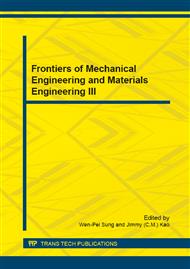p.277
p.280
p.284
p.288
p.292
p.299
p.305
p.309
p.313
Influence of Material and Constitutive Models on Friction Analysis for Modelling in Machining Cellular Metal Structures
Abstract:
The selection of an adequate friction model is an important aspect inthe finite element modeling of machining. Previously, different friction modelshave been compared, but the influence of the constitutive model or theworkpiece material have not been considered. This article focuses on theinfluence of the material and the constitutive model on the evaluation of thefriction model in machining. Numerical experiments are performed on threedifferent materials using different constitutive models. For every combinationof material and constitutive model, several simulations using different Coulombcoefficients, but the same cutting parameters, are performed. Several variablesare evaluated: cutting force, shear plane angle, chip-tool contact length,maximum temperature and maximum stress. The results reveal that the workpiecematerial plays an important role in the evaluation of the friction model. Theyalso show that there is significant influence from the constitutive models oncontact length, curvature ratio and chip thickness.
Info:
Periodical:
Pages:
292-298
Citation:
Online since:
January 2015
Authors:
Keywords:
Price:
Сopyright:
© 2015 Trans Tech Publications Ltd. All Rights Reserved
Share:
Citation:


